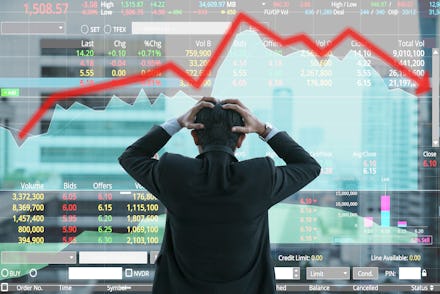Here's why the stock market is down — and how to protect your money

Even if you aren't an "investor investor," you (hopefully!) own some stocks — the building blocks for wealth — in a 401(k) or Individual Retirement Account aka IRA. And you might know 2017 has been good to stock investors so far.
The Dow Jones Industrial Average has broken multiple records, and there's renewed interest in IPOs as popular companies like Snapchat and Canada Goose go public, possibly a good sign for the United States economy.
But the market can turn on investors quickly. Stocks opened lower Wednesday morning, a day after the S&P 500 — an index tracking the 500 biggest U.S. stocks — posted its largest daily loss since October. As of Wednesday at 1:00 p.m. Eastern, the DJIA was down and the S&P 500 was flat for the day.
Stocks have experienced what's called a "sell-off," when traders begin rapidly selling a lot more shares than they buy. This increases the supply of shares and can make prices drop broadly. Conversely, the price of gold and other "safe haven" assets — which are popular during fearful times — rises.
Tuesday night and Wednesday morning, the sell-off spread around the world, sending markets down in Europe and Asia as well, as Bloomberg reported. What gives? And what should you do? Here's a little explainer.
Why are stocks selling off right now?
There are a few theories. Markets can be irrational, and they often overreact to news whether good or bad. A sell-off doesn't necessarily mean the "good times are over," as one chief investment officer told the Financial Times.
One theory is investors fear President Donald Trump may be too bogged down in the controversial GOP health care bill and Russia scandals to deliver on pro-business promises like tax cuts or pulling back on regulations.
"The progression of Trump's policies through Congress would definitely be a key indicator of the market ... one of the major causes for the pullback," Lindsey Bell, an investment strategist with CFRA Research, said. "If [the health care law] doesn't pass, the market will be skeptical of other policies passing ... but if it passes with flying colors the market will view that favorably."
But that's certainly not all that's going on, Bell said. For one, the stock market has been doing well for a while, which means a pullback could be healthy. In a recent Bank of America survey of investors, one in three said they thought that stock market prices were too high, the most in 17 years.
"It was back in October that we had the last 1% pullback on a daily basis in the market," Bell said. "And that makes people a little bit nervous."
Another explanation? The Federal Reserve raised interest rates twice in the last several months. When rates go up, it means people pay more on credit cards and mortgage payments, which means less spending money. That can be bad for business and, by extension, stock prices.
A final theory is that the real reason for the pullback is purely technical— and would have happened regardless of politics, thanks to a set expiration dates on several kinds of "options," investment products that let you bet that a stock will rise or fall a certain amount by a given date.
March 17 marked a big date for options: On the third Friday of March, June, September and December, four kinds of options all expire simultaneously in what's known as a "quadruple witching." It's less spooky than it sounds.
During a quadruple witching, lots of trades get executed automatically if a stock in question rose or fell a certain amount, depending on what kind of options people were buying. That can lead to price discrepancies, market volatility and, as may have been the case Tuesday, a market sell-off.
What to do when stock prices drop
In volatile times, it's important to think about your risk tolerance, said NerdWallet's Arielle O'Shea. Make sure your investments are diversified, and do not panic when stocks take a dip. Indeed, a market downturn may even be an opportunity for younger investors, who have long investment horizons (aka lots of time before retirement): That's another good reason to take on risk.
But many robo-advisers rely on risk tolerance to design your portfolio, and it is important to be honest with yourself if you are a skittish person who checks their 401(k) balance a lot. It's better to take less risk than to take risk you can't handle. Holding bonds in addition to stocks can help create balance.
"It's much better to be a little safer than to try and pull out and lose money every time you get scared," O'Shea said. "Especially now that it's been a bull market for so long, I don't know if now is the time to jump in and be 100% stocks, especially if you've never done it before. Because there's a good chance to get some swings."
If you aren't sure what your risk tolerance is, O'Shea said, set up a more conservative portfolio that includes bonds: at least 10%. If this market downturn or others in the future don't faze you, then you probably have the appetite to slowly add stocks, which can yield you much better returns over time. And market corrections are great times to buy equities — on sale.
Sign up for The Payoff — your weekly crash course on how to live your best financial life. Additionally, for all your burning money questions, check out Mic's credit, savings, career, investing and health care hubs for more information — that pays off.